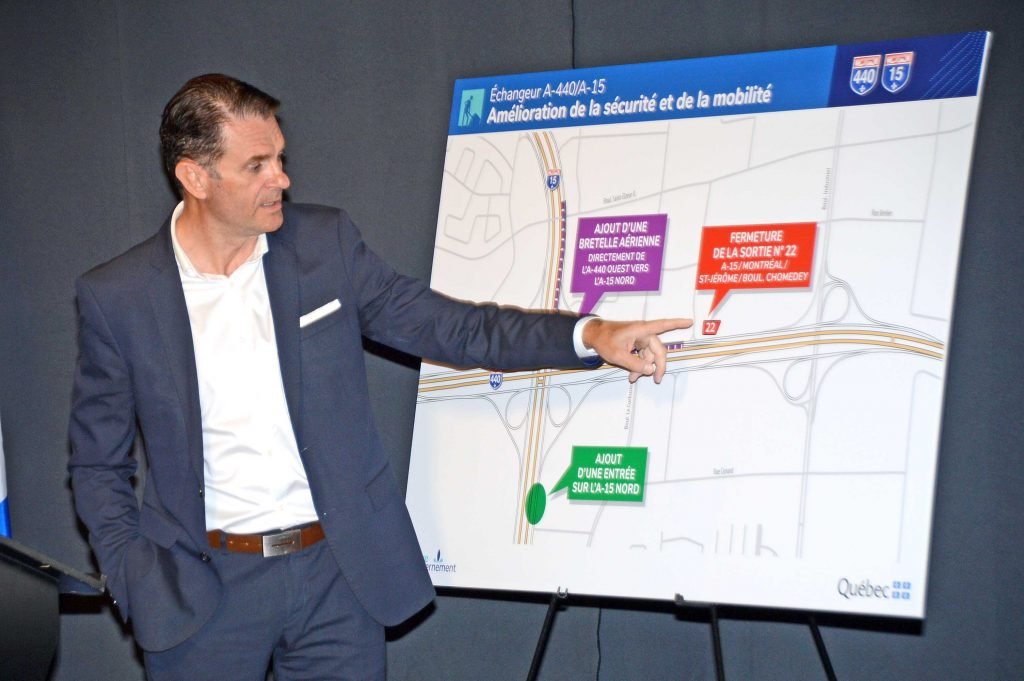Four people died in a fiery crash at local autoroute crossroads last year
Nearly a year after a tragic collision in Laval at the intersection of Autoroutes 15 and 440 that saw four people killed and 15 others injured, the Quebec Ministry of Transport announced recently that a major restructuring of the busy crossroads will be taking place to make it safe regardless of the volume of traffic passing through.
The principal solution to the longstanding traffic management dilemma at the crossroads proposed by Transport Quebec is a flyover overpass to connect the A-440 westbound to the A-15 going north.

The strategy will also involve permanently closing the current Exit 22 (Montreal/St-Jérôme/Chomedey Blvd.) on the A-15 (which is where the accident took place), while creating a new on ramp on the A-15 just south of the A-440.
The junction in question, created around 50 years ago, is one of the busiest and most notorious in Quebec, with several hundred thousand drivers per day trying to navigate a layout that’s known to create confusion. Over the years, it’s been the site of crashes too numerous to calculate.
A real bottleneck
The problem up to now, as almost everyone in Laval who has been through the interchange knows, is that massive amounts of traffic heading for the A-15 come to a dead stop in the exit lane, and sometimes spill over into the passing lanes on the A-440 – especially during rush hours.
In the meantime, traffic headed westbound whizzes past at full speed, sometimes scarcely missing the stationary vehicles. As well, the hundreds of vehicles backed up while exiting from the A-440 have to negotiate their way through a wide section of the busy service road to get over to the A-15 entrance ramp.
On Aug. 5 last year, four people were killed and 15 others were injured in a fiery multi-vehicle pileup in that spot. The collision involved two tractor-trailers and seven cars. Although accidents were common at the intersection long before then, it took last year’s catastrophic accident to finally motivate the provincial government into doing something.
Remembering the victims
“Despite this good news, my thoughts are with all the people who died or who were injured in this location and the members of their families,” Mayor Marc Demers said during a press conference in Laval on July 17 that was attended by Quebec Transport Minister François Bonnardel, Finance Minister Éric Girard and Sainte-Rose MNA Christopher Skeete.
Demers said he was impressed with the government’s steadfast determination to resolve the longstanding problem. “I’d like to thank you for taking action. For us, this is a major thing. When we consider all the projects underway now, to be able to have taken on this one is remarkable.”
“Laval is a magnet for families, but also for a good number of businesses and industries,” Sainte-Rose MNA Christopher Skeete pointed out. “These improvements on the arteries that cross the heart of our city will not only ensure a better quality of life for the population, but also the continuing development of the region.”
Improving security
“The new infrastructures will simultaneously allow for the improvement of the security of road users and the flow of traffic on one of the busiest exchanges in Quebec,” said the transport minister, while adding that the measures will supplement stop-gap improvements Transport Quebec implemented immediately after the accident.
“By ensuring there is better traffic flow in that key area, the entire population of Laval will be benefiting from the positive effects, whether in terms of security or on the social and economic level,” said Finance Minister Girard who is also the minister responsible for the Laval region.
Although the estimated cost for the work isn’t yet known, but the bidding process is underway, the first phase of work is scheduled to begin in 2022, with delivery expected by late 2023. According to Transport Quebec, the A-15/A-440 interchange is used by 305,000 vehicles daily.



